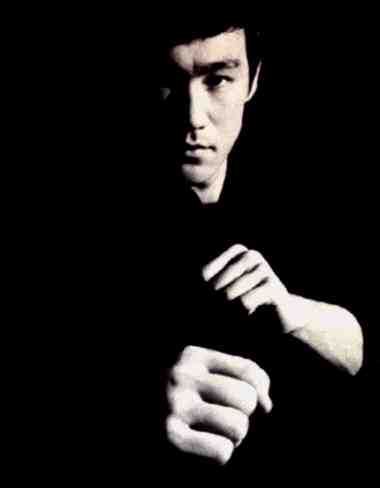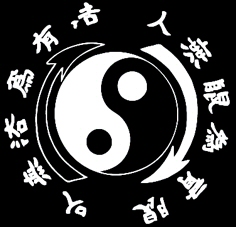Academy of Jeet Kune Do Fighting Technology
Athens
Greece
Jun Fan Jeet Kune Do Instructor
Vagelis Zorbas








ATTACK BY COMBINATION: William Holland (right) assumes a fighting stance in front of a striker (1). Because Holland believes he has a grappling advantage, he launches a back-hand strike (2) and a left cross (3), both of which the opponent nullifies. Holland then moves on to his true mission: to lock the opponent’s lead arm (4) and force him to the ground (5). Once he falls, the jeet kune do practitioner ups the pressure he exerts on the trapped limb as he uses his knee to pin the other man.
Jeet Kune Do
Attributes Training
Speed
The quality of speed can be broken down into
two main categories. They are Reaction speed and movement speed. Each of
these types of speed can be broken down into many minor variations such as
visual awareness, alteration speed, footwork speed, hand trapping speed,
etc. However, these are subcategories of either: 1- speed of your motor
reaction; or 2- speed of your movement. It is also very diverse. A fighter
may have fast hand motions butt slow footwork. Likewise, another may have
slower reaction speed but compensates for it with faster perceptual speed.
Thus to say an individual is fast and another slow is an oversimplified
generalization. A lot of one’s speed is also inherent. However, various
aspects of speed can be increased in everyone to some degree. Let’s take
a look at each type of speed in-depth.
Movement speed
Movement speed can be defined as the ability
to generate bodily movements in the shortest possible time – be it a
simple movement or a complex movement. Motor speed can be a deciding
factor in one’s fighting abilities.
Some of the prerequisites are:
- Mobility of Nervous
Processes – Fine-tuned neuromuscular skill and abilities.
- Power Performance - The
ability to explode from one’s neutral position.
- Muscle Flexibility and
Elasticity – Necessary for full range of motion and to cut down
muscular resistance which can slow a movement.
- Proper Focus of One’s
Attention.
- Willpower.
Many factors other than basic speed
abilities also condition movement speed. These are such things as
strength, endurance, coordination, technical skill, etc.
Any punching or kicking movement is
basically a ballistic motion (like a bullet). On the way to it’s target
the weapon is being acted on by inertia. Even as your arm or leg is
extending on it’s way outward the antagonistic muscles are preparing to
fire and slow the movement to stop it in order to prevent you from
injuring yourself. If it doesn’t then you may end up hyperextending the
joint. Even so you must keep the antagonistic muscles as relaxed as
possible to truly "explode" a punch. In this case, the more
powerful the explosion of your initial movement is, the faster the punch
or kick will travel.
Reaction Speed
Reaction speed, like movement speed, is also
conditioned by other factors. These include proper focus and concentration
on the subject to be responded to; fatigue (physical or mental); awareness
(visual, aural, tactile), etc. It can also be divided into: 1- simple
motor reaction; and 2- complex motor reactions. A simple motor reaction
may be all that is required against a single attacking motion, whereas a
complex one may be necessary against a combination attacking motion.
Most of the reactions prevalent in the
martial arts are complex in that, due to constant and sudden changes in
situations or actions, the martial artist has to select from several
possible actions the one adequate to the situation.
Power
Power is the ability to exert strength
quickly. In fact, in Europe it is often referred to as speed-strength. The
primary key is to develop the greatest amount of force in the shortest
amount of time. The initial concentric contraction of the prime mover is
literally an "explosion" within the muscle and incorporation of
all the body parts to impact maximum torque (proper body mechanics).
As an example, when the hook punch lands we
want the entire body behind it to maximize the power; thus the term
"hitting with the whole body" and not merely the arm or leg.
Russian studies have proven that approximately one third of the power in a
punch comes from the feet and the lower body, one third comes from the
waist, and one third comes from the shoulder and arm.
To express power while moving forward we
need to make sure that the punch (or kick) lands just a fraction of a
second before our lead foot touches the ground, allowing the person’s
total weight to be projected into the opponent instead of downward into
the floor.
Endurance
Endurance can be defined as the capacity to
resist fatigue. High levels of endurance facilitate the mastery of a lot
of hard work during training and allow high quality movement and perfect
solutions to both technical and tactical problems for the entire training
session. There is an old saying that "when endurance goes out the
window everything else usually follows." Well-developed endurance
abilities are also important for a quick recovery following a hard
workout.
There are various types of endurance as
well, such as strength-endurance and speed-endurance, basic endurance and
specific-endurance. In training, the so-called basic endurance is the
functional base for all the other various kinds of endurance. It is during
this basic endurance training that one’s personality traits such as
self-discipline and willpower are developed. Motivation and willingness to
take pain are two psychological elements involved in such training.
Coordination
Coordination is the quality, which enables
the martial artist to integrate all the powers, and capacities he has into
the effective doing of an act. It is the ability to move and organize
yourself around your own physical body. Coordination abilities differ from
technical skills in that they exist as prerequisites for subsequent motor
actions.
Seven coordinative abilities can be
differentiated by their characteristics, and while all seven are
fundamental to martial arts as a whole they may appear in quite different
values in each person.
These abilities are:
- Combinatory Ability
– The ability to coordinate parts of body movements and single
movements with one another in relation to a total movement of the body
towards a given action. In contests between individuals where there is
confrontation with a moving opponent, numerous complicated and rapid
adjustments are necessary (combining lower body action with
- Orientation –
Knowing where you are at any given moment. It is the ability to
analyze and change the position and movement of the body in space and
at the same time relate to the area in which the action is taking
place (a boxing ring, for instance)
- Differential Ability
– The ability to achieve a high degree of accuracy and fine
adjustment of separate body movements and mechanical phases of a total
body movement. This is related to the perfecting and stabilizing of
technical skills and their actual application in bouts between
individuals where there is a high precision in various situations
despite the actions of opponents. Agility would be
included in this category. Agility is the ability to exercise a fine
coordination of the movements of various parts of the body as well as
the ability to relax the muscles which produces a conscious tuning of
the muscle tone.
- Balance – The
ability to maintain the whole body in dynamic equilibrium.
- Reactive Ability
(Good Reactions) – The ability to initiate quickly and to perform
rapid and well-directed actions following a signal.
- Adaptive Ability
– The ability to modify a sequence of actions to new conditions, or
observing anticipated changes in the situation, or to continue the
sequence in another way.
- Rhythmic Sense – The ability to observe the characteristic uniform recurrence of a beat within measured movement.
Precision
Precision can be defined as accuracy in a
particular movement or projection of force. It means being able to place
your weapon of attack exactly on the desired location. It is one thing to
have the ability to hit a stationary target precisely, but much more
difficult to place that hit perfectly on a target that is not only moving
but also trying to score on you.
As it is a fine skill, precision work should
be practiced when you are freshest for the maximum benefit. It can be
trained simultaneously with speed work, for it is better to concentrate on
speed and accuracy first before working the same action with speed and
power.
Balance
Balance is the quality of achieving an inner
relationship between all the points of your body. It is an active state,
constantly going on and continually shifting. Thus the balance you seek is
dynamic balance, or balance in motion, nor in stillness (stances).
Sometimes it is even possible to use a momentary loss of balance to
facilitate faster movement.
